A Comprehensive Performance Characterization of a Nanofluid-Powered Dual-Fluid PV/T System under Outdoor Steady State Conditions
Abstract
:1. Introduction
| Authors | Particles Size | Concentration | Base Fluid | Applications/Investigations |
|---|---|---|---|---|
| Heris et al. [14] | 50–60 nm | 0.2–3 vol.% | Water | The authors examined the increased heat transfer coefficient of CuO nanofluid with increasing concentration of the nanoparticles and Peclet number. It was concluded that the optimal concentration of CuO nanoparticles is between 2.5% and 3%. |
| Menbari et al. [15] | <100 nm | 0.002–0.008 vol.% | water | The study investigated the thermal performance of CuO nanofluid for application to a direct absorption concentrating parabolic solar collector (DAPSC). Both experimental and numerical findings revealed that the thermal efficiency of DAPSC increased with increasing nanoparticle volume fraction and fluid flow rate. |
| Karami et al. [16] | <40 nm | 25–100 Vol. fraction (ppm) | water and Ethylene glycol mixture | In this study, CuO nanofluid-based solar collector was built for residential applications in particular as a domestic water heater. The proposed colloidal solution was further assessed for its thermal-physical and optical properties. |
| Chen et al. [17] | 200 nm | Mass concentration 0.01–0.1% | Paraffin | The authors observed that by adding a small amount of CuO nanopowder to PCM (paraffin), a significant enhancement in the solar absorption ability of the resultant composite PCM was observed. |
| Bellos and Tzivanidis [18] | - | 6 vol.% | Syltherm 800 | CuO nanoparticles dispersed in Syltherm 800 was used as a heat transfer fluid for a solar linear Fresnel reflector. Compared to conventional thermal oil, the CuO dispersed in Syltherm 800 proved to be beneficial in the context of improving the thermal efficiency and operation under high-temperature levels. |
| Venkitaraj et al. [19] | 40–50 nm | Mass concentration 0.1% | Neopentyl-glycol | The main objective of this study was to experimentally analyze the impact of CuO nano-additives on the heat extraction performance of Neopentylglycol for building cooling applications. |
| Malekan et al. [20] | 10–250 nm | 2–4 vol.% | Therminol 66 | In this study, a CuO/Therminol 66 nanofluid is examined as a potential solution for performance improvement of a parabolic trough solar collector. Under an external magnetic field, a significant rise in thermal efficiency was noticed. |
| Mustafa et al. [21] | 40 nm | 0.1 vol.% | Water | The authors examined the usefulness of CuO nanofluid in a flat plate solar collector for assisting a hot process stream. It was found that by loading CuO nanoparticles, the thermal performance of a solar-assisted hot process stream was improved by 12.8%. |
2. Energy and Performance Analyses
3. Experimentation
3.1. Experimental Setup
3.2. Dual-Fluid PV/T System Design
3.3. Measurement
3.4. Uncertainty Analysis
3.5. Nanofluid Preparation
4. Results and Discussion
4.1. Comparison of Indoor and Outdoor-Based Testing
4.2. Outdoor Performance Evaluation
5. Conclusions
Author Contributions
Funding
Institutional Review Board Statement
Informed Consent Statement
Data Availability Statement
Conflicts of Interest
Nomenclature
| mass flow rate (kg/s) | |
| specific heat of the fluid (J/kg °C) | |
| specific heat of air (J/kg °C) | |
| specific heat of nanofluid (J/kg °C) | |
| fluid inlet temperature (°C) | |
| fluid outlet temperature (°C) | |
| air inlet temperature (°C) | |
| air outlet temperature (°C) | |
| nanofluid inlet temperature (°C) | |
| nanofluid outlet temperature (°C) | |
| ambient air temperature (°C) | |
| heat removal factor | |
| overall heat loss coefficient (W/m2 °C) | |
| collector surface area (m2) | |
| solar radiation (W/m2) | |
| useful power (W) | |
| useful power produced by dual-fluid (W) | |
| electric power (W) | |
| max current (A) | |
| short-circuit current (A) | |
| max voltage (V) | |
| open circuit voltage (V) | |
| filling factor | |
| Reynolds number | |
| & | width and depth of the air channel (m) |
| hydraulic diameter of the pipe (m) | |
| Greek letter | |
| mass (kg) and density (kg/m3) of nanoparticles | |
| mass (kg) and density (kg/m3) of base-fluid | |
| transmissivity of glass | |
| absorptivity of PV solar cells | |
| volume concentration | |
| efficiency | |
| electric efficiency | |
| dual-fluid PV/T efficiency | |
| primary energy savings efficiency | |
| power plant conversion efficiency | |
References
- Qiu, Z.; Ma, X.; Zhao, X.; Li, P.; Ali, S. Experimental investigation of the energy performance of a novel Micro-encapsulated Phase Change Material (MPCM) slurry based PV/T system. Appl. Energy 2016, 165, 260–271. [Google Scholar] [CrossRef]
- Aberoumand, S.; Ghamari, S.; Shabani, B. Energy and exergy analysis of a photovoltaic thermal (PV/T) system using nanofluids: An experimental study. Sol. Energy 2018, 165, 167–177. [Google Scholar] [CrossRef]
- Al-Waeli, A.H.; Sopian, K.; Chaichan, M.T.; Kazem, H.A.; Ibrahim, A.; Mat, S.; Ruslan, M.H. Evaluation of the nanofluid and nano-PCM based photovoltaic thermal (PVT) system: An experimental study. Energy Convers. Manag. 2017, 151, 693–708. [Google Scholar] [CrossRef]
- Ebaid, M.S.; Ghrair, A.M.; Al-Busoul, M. Experimental investigation of cooling photovoltaic (PV) panels using (TiO2) nanofluid in water-polyethylene glycol mixture and (Al2O3) nanofluid in water-cetyltrimethylammonium bromide mixture. Energy Convers. Manag. 2018, 155, 324–343. [Google Scholar] [CrossRef]
- Huang, W.; Marefati, M. Energy, exergy, environmental and economic comparison of various solar thermal systems using water and Thermia Oil B base fluids, and CuO and Al2O3 nanofluids. Energy Rep. 2020, 6, 2919–2947. [Google Scholar] [CrossRef]
- Manigandan, S.; Kumar, V. Comparative study to use nanofluid ZnO and CuO with phase change material in photovoltaic thermal system. Int. J. Energy Res. 2019, 43, 1882–1891. [Google Scholar] [CrossRef]
- Muzaidi, N.A.S.; Fikri, M.A.; Wong, K.N.S.W.S.; Sofi, A.Z.M.; Mamat, R.; Adenam, N.M.; Yunin, M.Y.A.M.; Adli, H.K. Heat absorption properties of CuO/TiO2/SiO2 trihybrid nanofluids and its potential future direction towards solar thermal applications. Arab. J. Chem. 2021, 14, 103059. [Google Scholar] [CrossRef]
- Pattanayak, B.; Mund, A.; Jayakumar, J.; Parashar, K.; Parashar, S.K. Estimation of Nusselt number and effectiveness of double-pipe heat exchanger with Al2O3–, CuO–, TiO2–, and ZnO–water based nanofluids. Heat Transf. 2020, 49, 2228–2247. [Google Scholar] [CrossRef]
- Alkasmoul, F.S.; Al-Asadi, M.; Myers, T.; Thompson, H.; Wilson, M. A practical evaluation of the performance of Al2O3-water, TiO2-water and CuO-water nanofluids for convective cooling. Int. J. Heat Mass Transf. 2018, 126, 639–651. [Google Scholar] [CrossRef] [Green Version]
- Minea, A.; Moldoveanu, M. Studies on Al2O3, CuO, and TiO2 water-based nanofluids: A comparative approach in laminar and turbulent flow. J. Eng. Thermophys. 2017, 26, 291–301. [Google Scholar] [CrossRef]
- Du, M.; Tang, G.; Wang, T. Exergy analysis of a hybrid PV/T system based on plasmonic nanofluids and silica aerogel glazing. Sol. Energy 2019, 183, 501–511. [Google Scholar] [CrossRef]
- Abu Bakar, M.N.; Othman, M.; Hj Din, M.; Manaf, N.A.; Jarimi, H. Design concept and mathematical model of a bi-fluid photovoltaic/thermal (PV/T) solar collector. Renew. Energy 2014, 67, 153–164. [Google Scholar] [CrossRef]
- Jarimi, H.; Bakar, M.N.A.; Othman, M.; Din, M.H. Bi-fluid photovoltaic/thermal (PV/T) solar collector: Experimental validation of a 2-D theoretical model. Renew. Energy 2016, 85, 1052–1067. [Google Scholar] [CrossRef]
- Heris, S.Z.; Etemad, S.G.; Esfahany, M.N. Experimental investigation of oxide nanofluids laminar flow convective heat transfer. Int. Commun. Heat Mass Transf. 2006, 33, 529–535. [Google Scholar] [CrossRef]
- Menbari, A.; Alemrajabi, A.A.; Rezaei, A. Heat transfer analysis and the effect of CuO/Water nanofluid on direct absorption concentrating solar collector. Appl. Therm. Eng. 2016, 104, 176–183. [Google Scholar] [CrossRef]
- Karami, M.; Akhavan-Bahabadi, M.; Delfani, S.; Raisee, M. Experimental investigation of CuO nanofluid-based direct absorption solar collector for residential applications. Renew. Sustain. Energy Rev. 2015, 52, 793–801. [Google Scholar] [CrossRef]
- Chen, M.; He, Y.; Ye, Q.; Zhang, Z.; Hu, Y. Solar thermal conversion and thermal energy storage of CuO/Paraffin phase change composites. Int. J. Heat Mass Transf. 2019, 130, 1133–1140. [Google Scholar] [CrossRef]
- Bellos, E.; Tzivanidis, C. Multi-criteria evaluation of a nanofluid-based linear Fresnel solar collector. Sol. Energy 2018, 163, 200–214. [Google Scholar] [CrossRef]
- Venkitaraj, K.; Suresh, S.; Praveen, B.; Nair, S.C. Experimental heat transfer analysis of macro packed neopentylglycol with CuO nano additives for building cooling applications. J. Energy Storage 2018, 17, 1–10. [Google Scholar] [CrossRef]
- Malekan, M.; Khosravi, A.; Syri, S. Heat transfer modeling of a parabolic trough solar collector with working fluid of Fe3O4 and CuO/Therminol 66 nanofluids under magnetic field. Appl. Therm. Eng. 2019, 163, 114435. [Google Scholar] [CrossRef]
- Mustafa, J.; Alqaed, S.; Kalbasi, R. Challenging of using CuO nanoparticles in a flat plate solar collector-Energy saving in a solar-assisted hot process stream. J. Taiwan Inst. Chem. Eng. 2021, 124, 258–265. [Google Scholar] [CrossRef]
- Bergman, T.L.; Incropera, F.P.; DeWitt, D.P.; Lavine, A.S. Fundamentals of Heat and Mass Transfer; John Wiley & Sons: New York, NY, USA, 2011. [Google Scholar]
- Cengel, Y. Heat and Mass Transfer: Fundamentals and Applications; McGraw-Hill Higher Education: New York, NY, USA, 2014. [Google Scholar]
- Chow, T.T.; Pei, G.; Fong, K.; Lin, Z.; Chan, A.; Ji, J. Energy and exergy analysis of photovoltaic–thermal collector with and without glass cover. Appl. Energy 2009, 86, 310–316. [Google Scholar] [CrossRef]
- Garg, H.; Adhikari, R.S. System performance studies on a photovoltaic/thermal (PV/T) air heating collector. Renew. Energy 1999, 16, 725–730. [Google Scholar] [CrossRef]
- Sardarabadi, M.; Passandideh-Fard, M.; Heris, S.Z. Experimental investigation of the effects of silica/water nanofluid on PV/T (photovoltaic thermal units). Energy 2014, 66, 264–272. [Google Scholar] [CrossRef]
- Baljit, S.S.S.; Chan, H.Y.; Audwinto, V.A.; Hamid, S.A.; Fudholi, A.; Zaidi, S.H.; Othman, M.Y.; Sopian, K. Mathematical modelling of a dual-fluid concentrating photovoltaic-thermal (PV-T) solar collector. Renew. Energy 2017, 114, 1258–1271. [Google Scholar] [CrossRef]
- Khalifa, A.J.N.; Banwan, M.A. Effect of Volume Fraction of γ-Al2O3 Nanofluid on Heat Transfer Enhancement in a Concentric Tube Heat Exchanger. Heat Transf. Eng. 2015, 36, 1387–1396. [Google Scholar] [CrossRef]
- Al-Waeli, A.H.; Chaichan, M.T.; Kazem, H.A.; Sopian, K. Comparative study to use nano-(Al2O3, CuO, and SiC) with water to enhance photovoltaic thermal PV/T collectors. Energy Convers. Manag. 2017, 148, 963–973. [Google Scholar] [CrossRef]
- Naik, B.A.K.; Vinod, A.V. Heat transfer enhancement using non-Newtonian nanofluids in a shell and helical coil heat exchanger. Exp. Therm. Fluid Sci. 2018, 90, 132–142. [Google Scholar] [CrossRef]
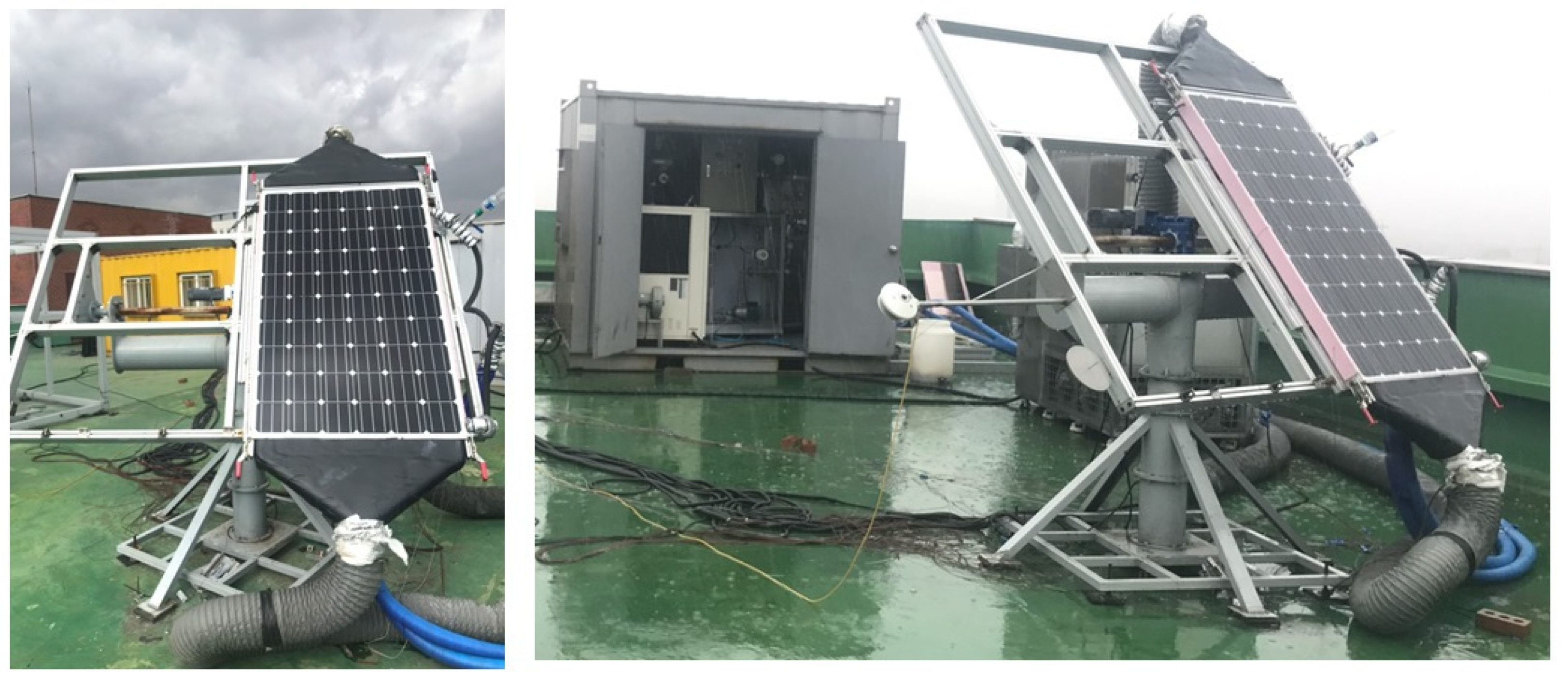
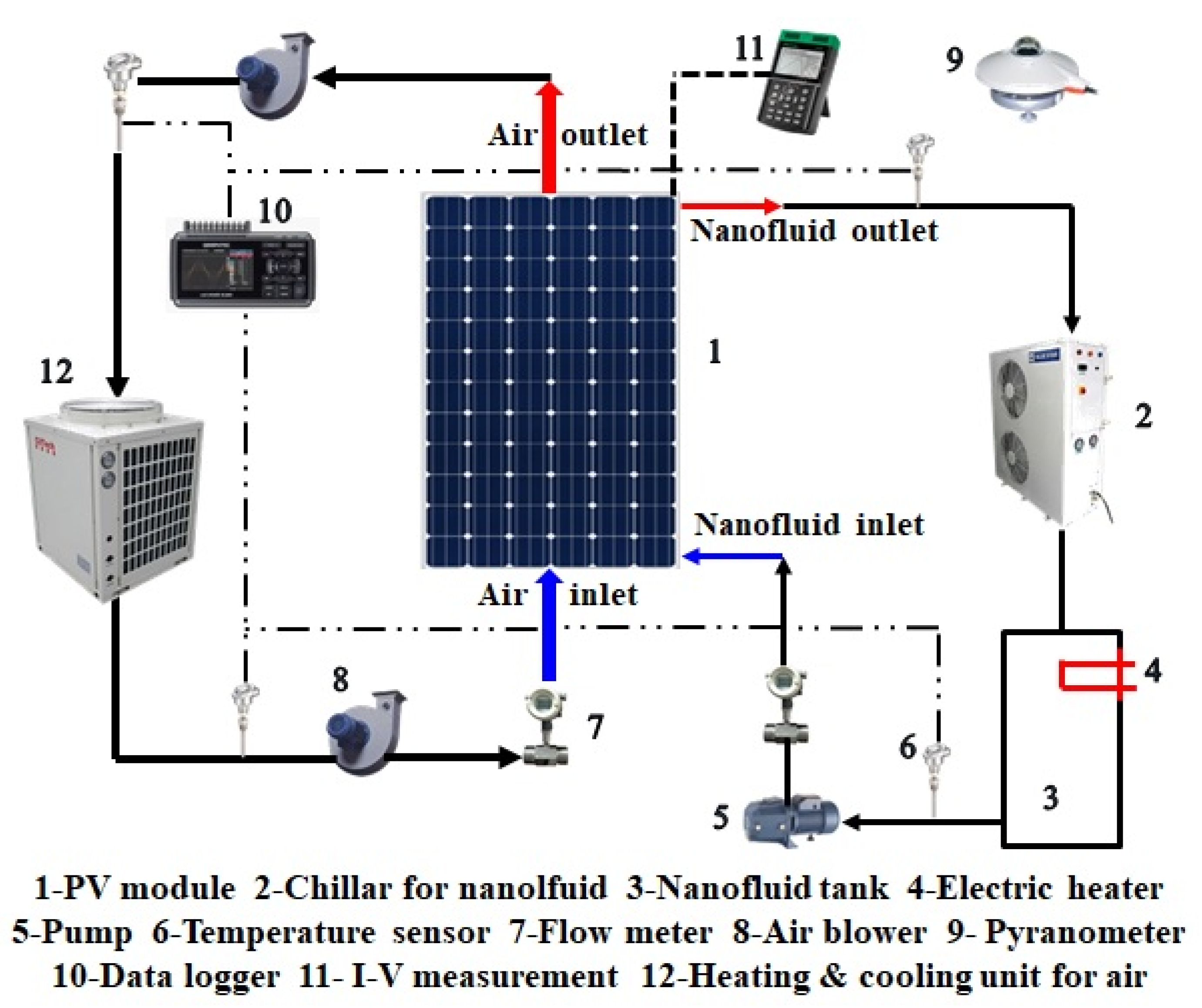
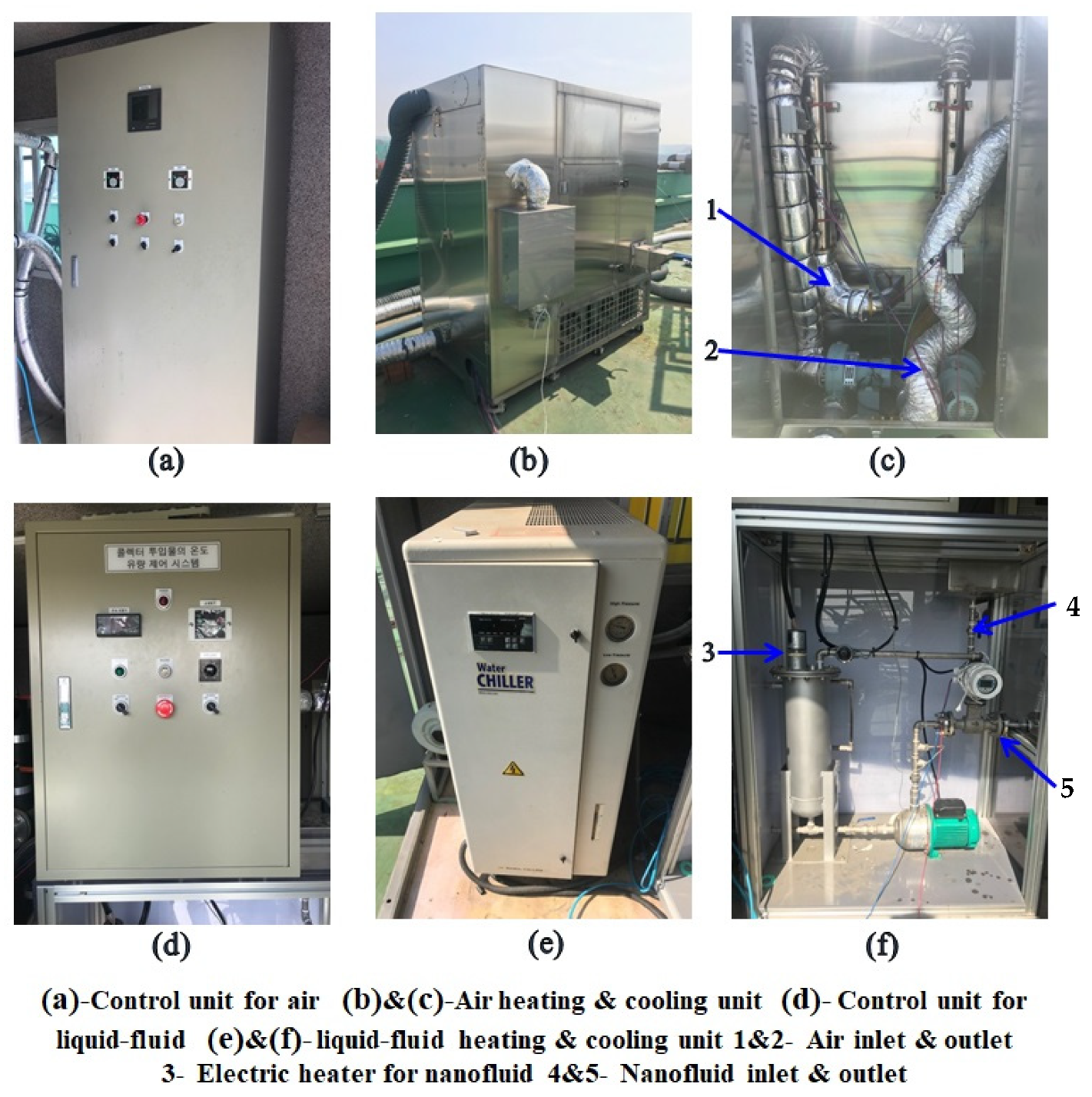
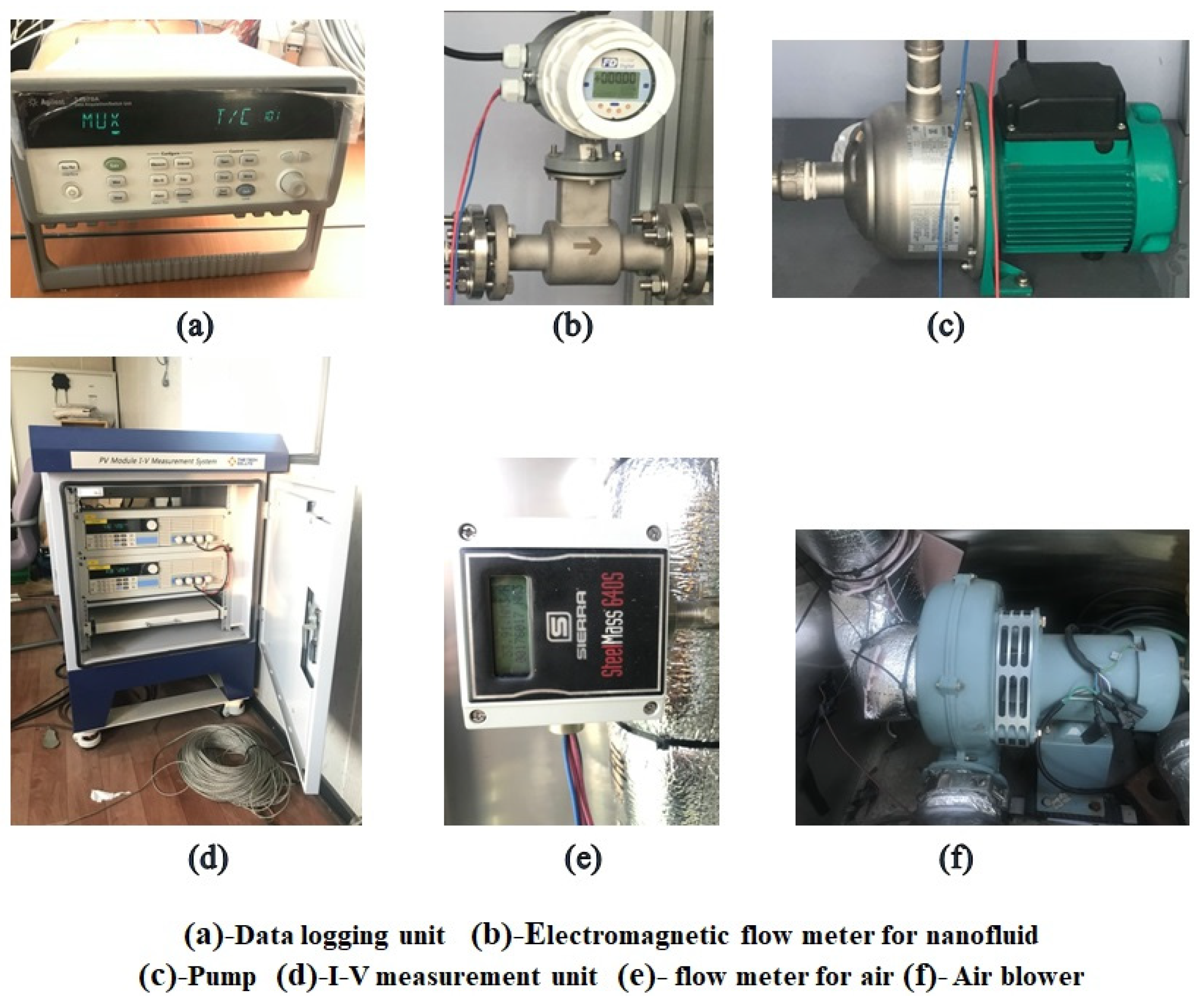
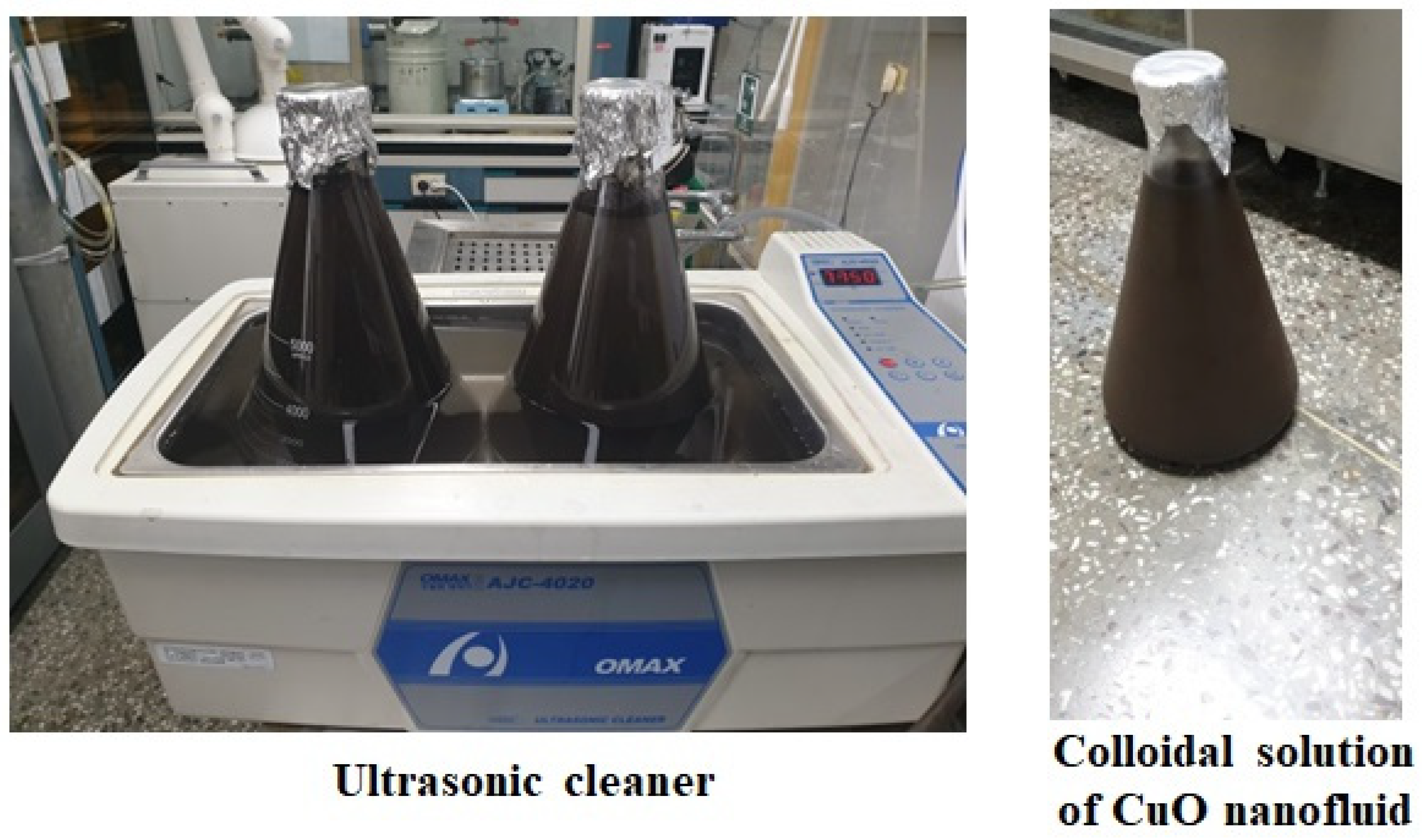
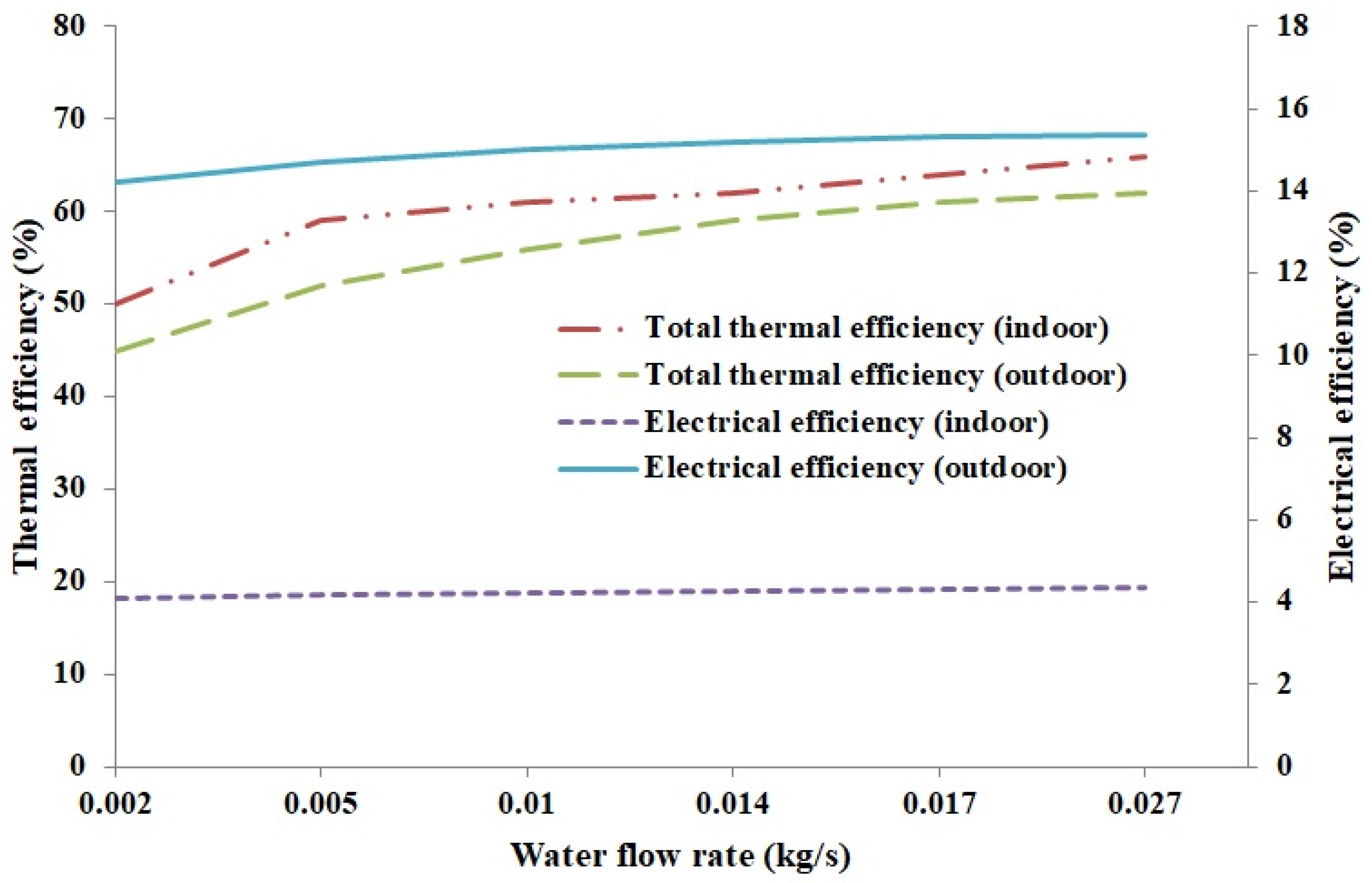
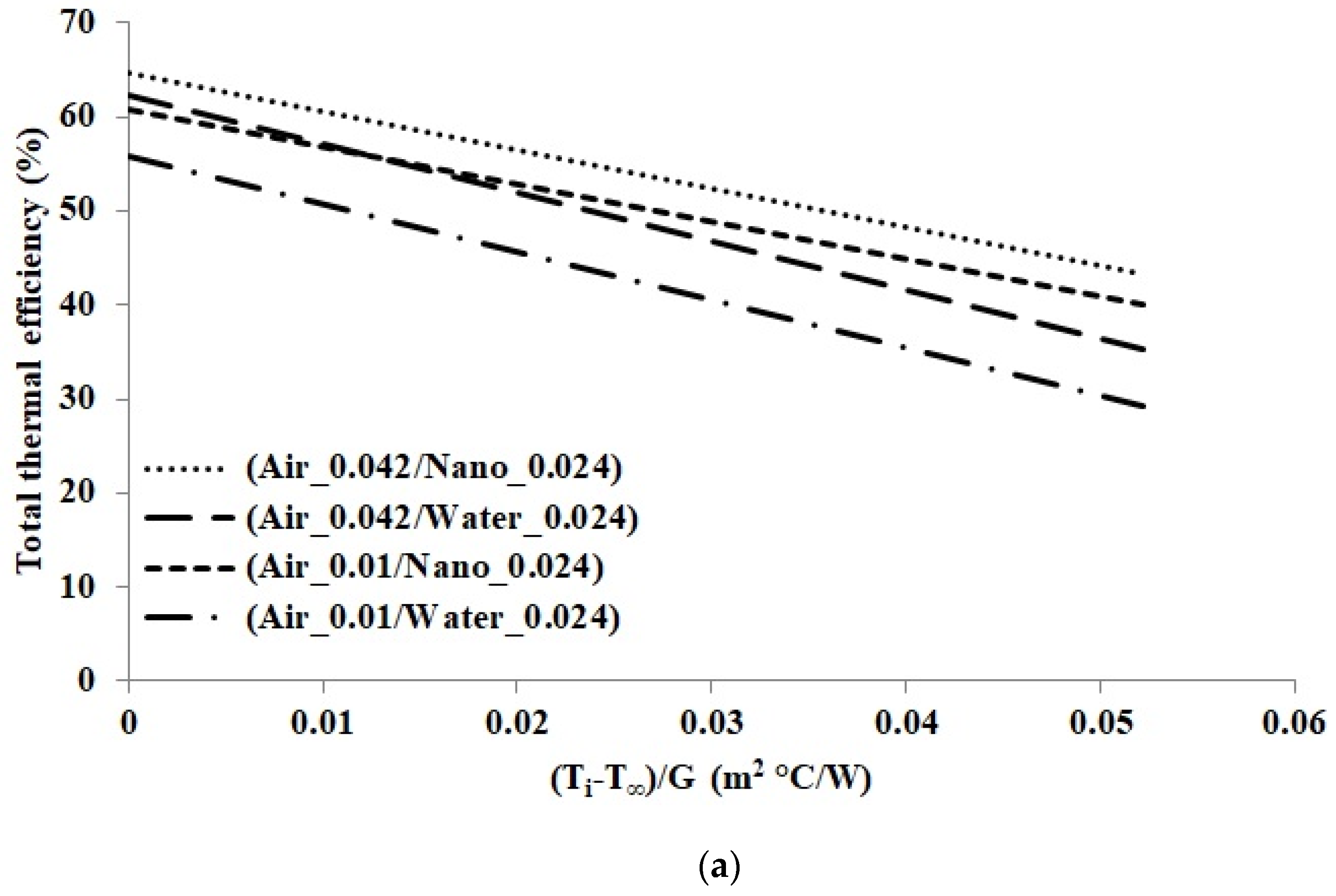


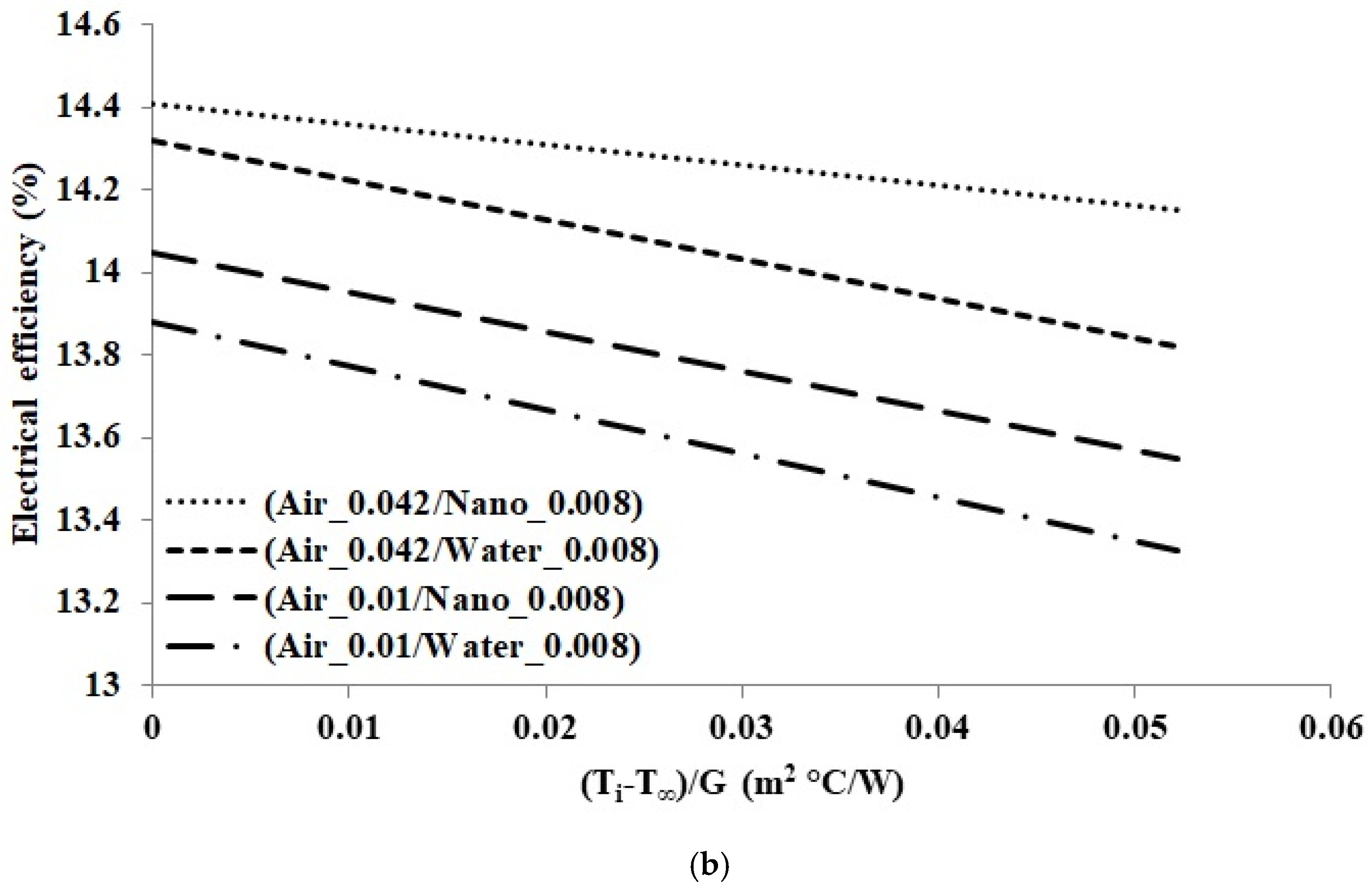
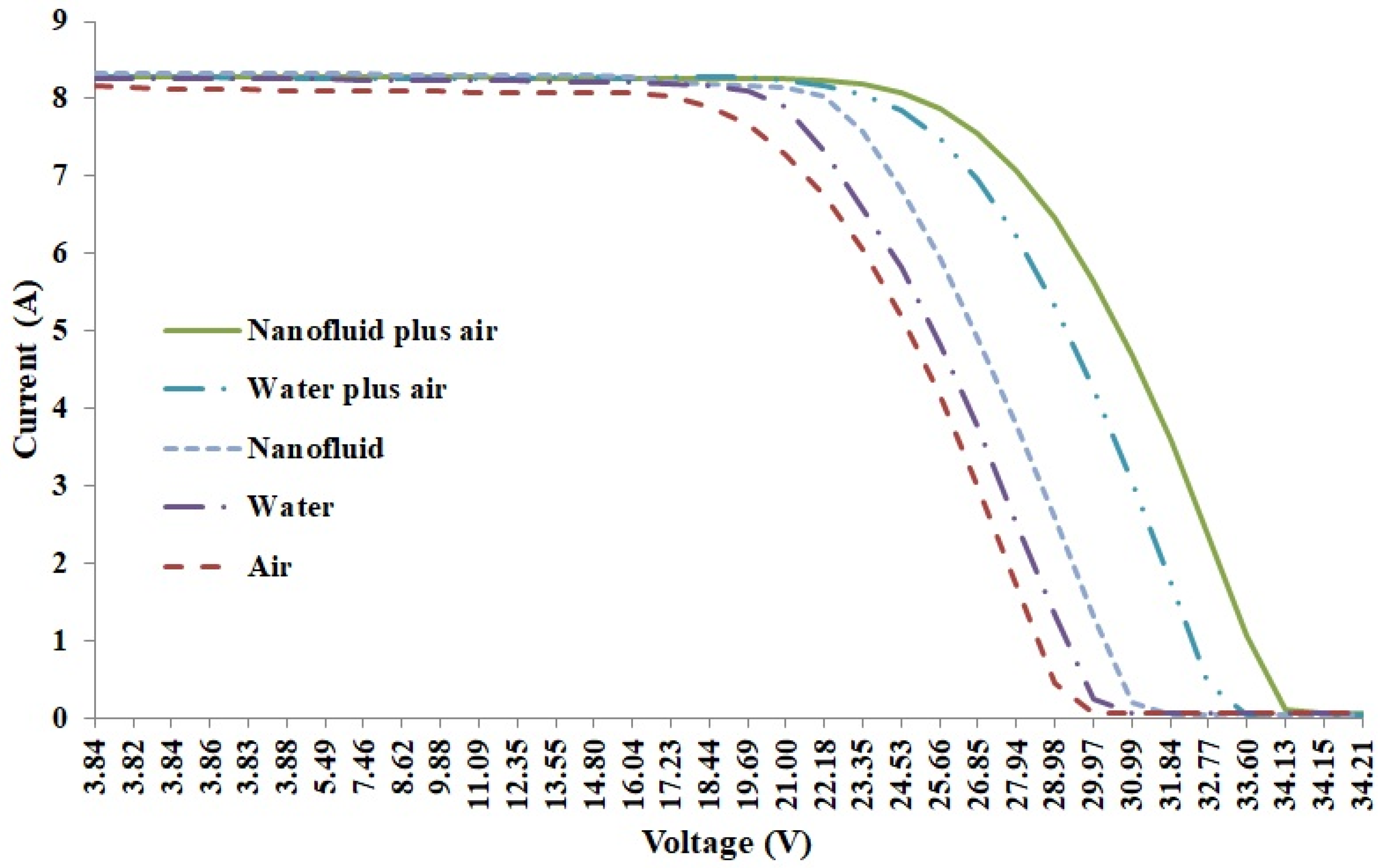

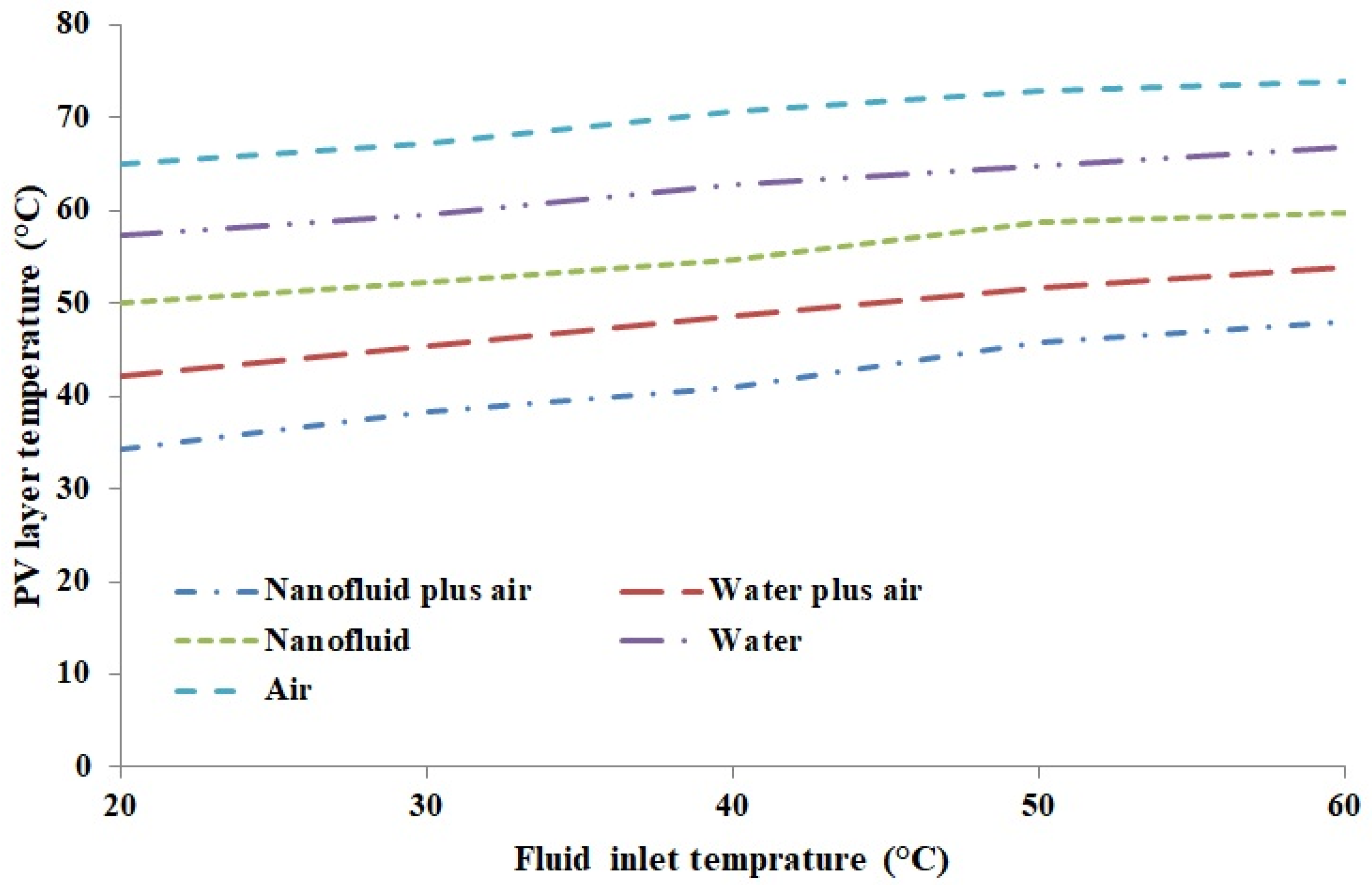
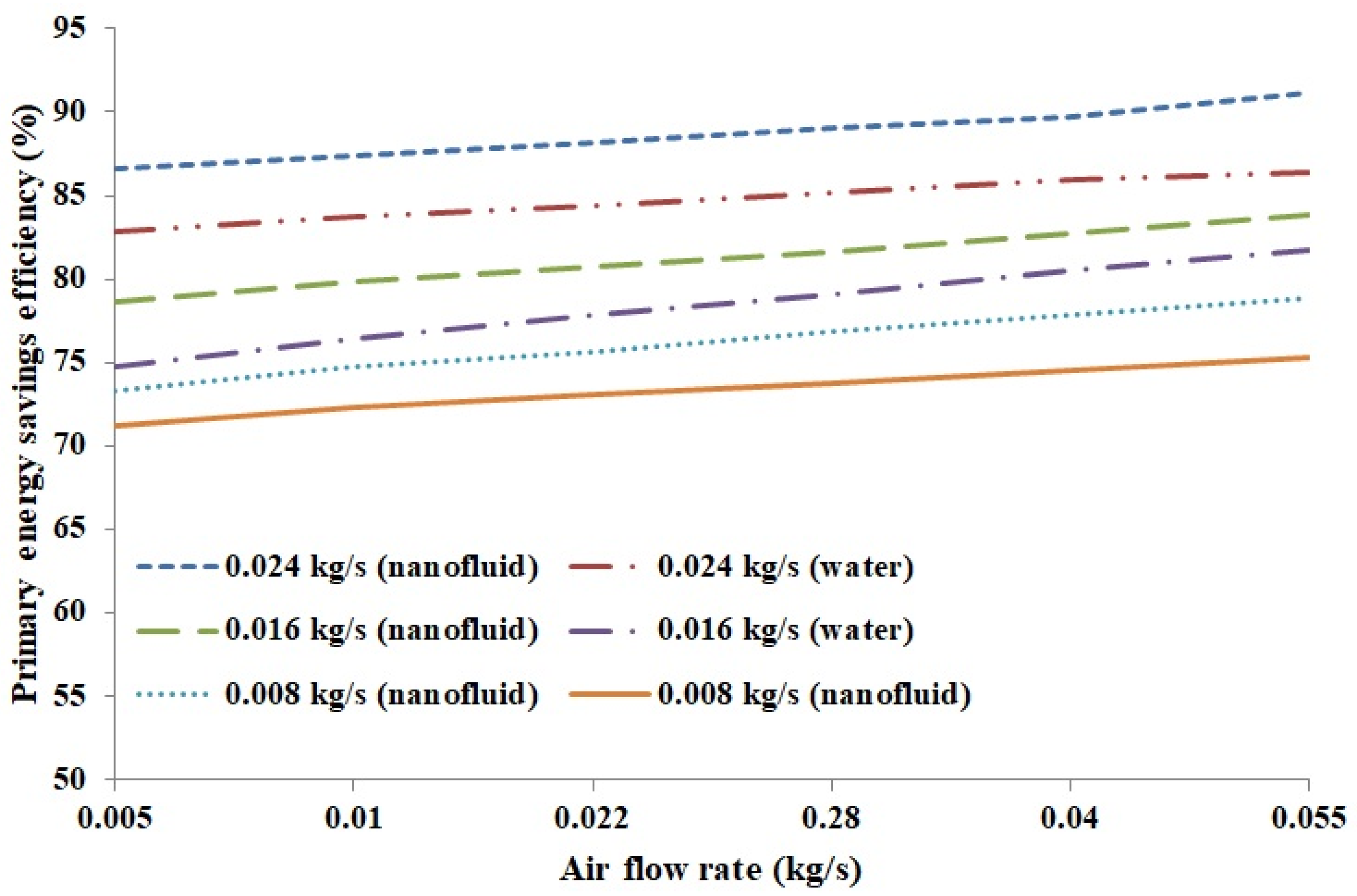

| Specifications | Descriptions |
|---|---|
| Cell type silicon | Mono-crystalline |
| Module size | 1619 mm ∗ 979 mm |
| Pmax | 260 W |
| Vmp | 31.6 V |
| Imp | 8.23 A |
| Voc | 38.1 V |
| Isc | 9.27 A |
| Aperture ratio | 48% (8 mm holes) |
| Specifications of the CuO Nanoparticles | |
|---|---|
| Grain size | 20–30 nm |
| Purity | 99.9% |
| Density | 6.48 g/cm3 at 25 °C |
| Thermal Conductivity | 33 W/m K |
| Melting point | 1326 °C |
| PH value | 7 at 20 °C |
| Supplier | HKK Solution South Korea |
| Simultaneous and Individual Fluid Operations (kg/s) | Temperature (°C) | Energy Input (W/m2) | Power (W) | ||||
|---|---|---|---|---|---|---|---|
| Nanofluid or Water Flow Rate | Air Flow Rate | Inlet for All Fluids | Outlet for Nanofluid or Water | Outlet for Air | Solar Radiation | Total Thermal | Electrical |
| Nanofluid | |||||||
| 0.008 | 0.01 | 20 | 32.9 | 35.7 | 957 | 609.99 | 235.3 |
| - | 0.028 | 21 | 31.81 | 33.48 | 978 | 697.32 | 236.8 |
| - | 0.042 | 19 | 26.84 | 29.39 | 968 | 706.03 | 238.4 |
| 0.016 | 0.01 | 14 | 23.12 | 22.72 | 988 | 733.89 | 241.4 |
| - | 0.028 | 17 | 25.81 | 24.37 | 955 | 778.36 | 243.5 |
| - | 0.042 | 13 | 20.7 | 21.4 | 1039 | 900.31 | 244.6 |
| 0.024 | 0.01 | 24 | 31.96 | 30.31 | 986 | 869.18 | 242.9 |
| - | 0.028 | 20 | 27.61 | 26.13 | 1001 | 915.65 | 247.3 |
| - | 0.042 | 24 | 31.31 | 30.89 | 1073 | 1032.50 | 251.8 |
| 0.008 | 0 | 21 | 34.95 | 932 | 486.10 | 240.4 | |
| 0.016 | 0 | 15 | 22.94 | 950 | 535.58 | 245.8 | |
| 0.024 | 0 | 16 | 23.36 | 1050 | 728.15 | 248.2 | |
| Water | |||||||
| 0.008 | 0.01 | 19 | 30.89 | 33.51 | 932 | 520.89 | 233.3 |
| - | 0.028 | 21 | 29.92 | 32.83 | 920 | 589.52 | 234.6 |
| - | 0.042 | 17 | 24.92 | 27.49 | 990 | 680.47 | 236.2 |
| 0.016 | 0.01 | 18 | 26.82 | 25.34 | 936 | 647.77 | 236.7 |
| - | 0.028 | 21 | 28.56 | 27.36 | 975 | 729.11 | 238.3 |
| - | 0.042 | 22 | 28.87 | 29.28 | 985 | 772.74 | 240.4 |
| 0.024 | 0.01 | 20 | 26.95 | 25.58 | 972 | 796.98 | 237.1 |
| - | 0.028 | 19 | 25.71 | 24.2 | 980 | 805.76 | 239.7 |
| - | 0.042 | 17 | 22.82 | 22.27 | 985 | 847.75 | 241.3 |
| 0.008 | 0 | 18 | 30.84 | 930 | 419.24 | 231.3 | |
| 0.016 | 0 | 20 | 27.56 | 989 | 502.82 | 232.5 | |
| 0.024 | 0 | 17 | 22.42 | 924 | 503.49 | 234.8 | |
| 0 | 0.01 | 19 | 37.45 | 910 | 181.50 | 213.3 | |
| 0 | 0.028 | 18 | 32.96 | 958 | 414.12 | 222.5 | |
| 0 | 0.042 | 12 | 22.88 | 1001 | 465.78 | 230.6 | |
Publisher’s Note: MDPI stays neutral with regard to jurisdictional claims in published maps and institutional affiliations. |
© 2021 by the authors. Licensee MDPI, Basel, Switzerland. This article is an open access article distributed under the terms and conditions of the Creative Commons Attribution (CC BY) license (https://creativecommons.org/licenses/by/4.0/).
Share and Cite
Hussain, M.I.; Lee, G.-H.; Kim, J.-T. A Comprehensive Performance Characterization of a Nanofluid-Powered Dual-Fluid PV/T System under Outdoor Steady State Conditions. Sustainability 2021, 13, 13134. https://doi.org/10.3390/su132313134
Hussain MI, Lee G-H, Kim J-T. A Comprehensive Performance Characterization of a Nanofluid-Powered Dual-Fluid PV/T System under Outdoor Steady State Conditions. Sustainability. 2021; 13(23):13134. https://doi.org/10.3390/su132313134
Chicago/Turabian StyleHussain, Muhammad Imtiaz, Gwi-Hyun Lee, and Jun-Tae Kim. 2021. "A Comprehensive Performance Characterization of a Nanofluid-Powered Dual-Fluid PV/T System under Outdoor Steady State Conditions" Sustainability 13, no. 23: 13134. https://doi.org/10.3390/su132313134
APA StyleHussain, M. I., Lee, G.-H., & Kim, J.-T. (2021). A Comprehensive Performance Characterization of a Nanofluid-Powered Dual-Fluid PV/T System under Outdoor Steady State Conditions. Sustainability, 13(23), 13134. https://doi.org/10.3390/su132313134







